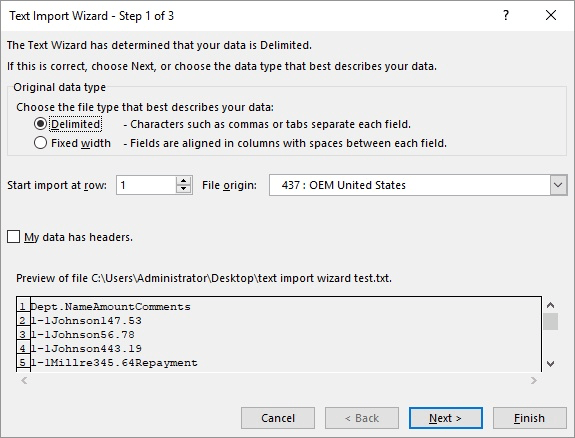Please Note: This article is written for users of the following Microsoft Excel versions: 2007, 2010, 2013, 2016, 2019, 2021, and Excel in Microsoft 365. If you are using an earlier version (Excel 2003 or earlier), this tip may not work for you. For a version of this tip written specifically for earlier versions of Excel, click here: Stopping Date Parsing when Opening a CSV File.
Written by Allen Wyatt (last updated June 1, 2024)
This tip applies to Excel 2007, 2010, 2013, 2016, 2019, 2021, and Excel in Microsoft 365
Marc has a user at his company who is trying to open a .CSV file in Excel. Some of the numbers in the file are in the format of "2-1" (or something similar). During the import, Excel parses this information as a date. If the piece of data is clearly something outside a valid date range (such as 2-134), then Excel imports it as would be expected. Marc is wondering how his user can force Excel to not parse this data as dates but to import them as text fields.
There are two easy ways you can approach this issue. First is to import the file in the following manner:

Figure 1. The Text Import Wizard.
The other way to approach the issue also involves the Text Import Wizard, but how you display it is different. In this approach, you use Windows to rename the file so that it has a .TXT extension instead of a .CSV extension. Now, when you use Excel to open the file, it displays the Text Import Wizard because it isn't quite sure how to interpret what it is going to be loading. You can use the Text Import Wizard in the same manner as already described earlier in this tip.
It should be noted that if you do this type of importing routinely (perhaps you need to import a particular file daily or weekly), then you may want to investigate using Power Query to do the importing. This tool is very powerful and you can use it to almost completely automate a specific import process.
ExcelTips is your source for cost-effective Microsoft Excel training. This tip (9179) applies to Microsoft Excel 2007, 2010, 2013, 2016, 2019, 2021, and Excel in Microsoft 365. You can find a version of this tip for the older menu interface of Excel here: Stopping Date Parsing when Opening a CSV File.

Dive Deep into Macros! Make Excel do things you thought were impossible, discover techniques you won't find anywhere else, and create powerful automated reports. Bill Jelen and Tracy Syrstad help you instantly visualize information to make it actionable. You’ll find step-by-step instructions, real-world case studies, and 50 workbooks packed with examples and solutions. Check out Microsoft Excel 2019 VBA and Macros today!
Excel provides different CSV formats you can use to export your workbook data for use with other programs. What are those ...
Discover MoreKeeping tabs on the size of a workbook can be important when using Excel. You have a couple of options that will allow ...
Discover MoreDelimited files are often created through Excel so that your data can be exported to other programs. If the delimited ...
Discover MoreFREE SERVICE: Get tips like this every week in ExcelTips, a free productivity newsletter. Enter your address and click "Subscribe."
There are currently no comments for this tip. (Be the first to leave your comment—just use the simple form above!)
Got a version of Excel that uses the ribbon interface (Excel 2007 or later)? This site is for you! If you use an earlier version of Excel, visit our ExcelTips site focusing on the menu interface.
FREE SERVICE: Get tips like this every week in ExcelTips, a free productivity newsletter. Enter your address and click "Subscribe."
Copyright © 2026 Sharon Parq Associates, Inc.
Comments